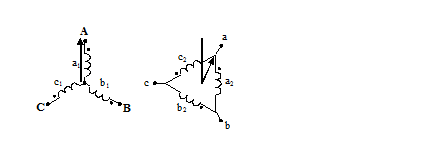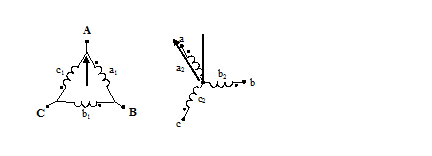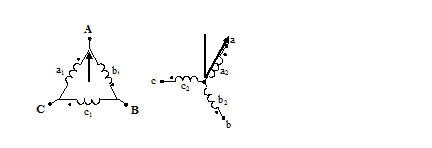Three-Phase Transformer (Two Windings)
(To be removed) Implement three-phase transformer with configurable winding connections
The Specialized Power Systems library will be removed in R2026a. Use the Simscape™ Electrical™ blocks and functions instead. For more information on updating your models, see Upgrade Specialized Power System Models to use Simscape Electrical Blocks.
Libraries:
Simscape /
Electrical /
Specialized Power Systems /
Power Grid Elements
Description
This block implements a three-phase transformer using three single-phase transformers. For a detailed description of the electrical model of a single-phase transformer, see the Linear Transformer block.
When activated, the saturation characteristic is the same as the one described for the Saturable Transformer block. If the fluxes are not specified, the initial values are automatically adjusted so that the simulation starts in steady state.
The leakage inductance and resistance of each winding are given in pu based on the
transformer nominal power Pn and on the nominal voltage of the winding
(V1 or V2). For a description of per units, refer to
the Linear Transformer and to the Saturable Transformer.
The two windings of the transformer can be connected as follows:
Y
Y with accessible neutral
Grounded Y
Delta (D1), delta lagging Y by 30 degrees
Delta (D11), delta leading Y by 30 degrees
If you select the Y connection with accessible neutral for winding 1, an input port labeled N is added to the block. If you ask for an accessible neutral on winding 2, an extra output port labeled n is generated.
The D1 and D11 notations refer to the clock convention that assumes that the reference Y voltage phasor is at noon (12) on a clock display. D1 and D11 refer respectively to 1:00 p.m. (delta voltages lagging Y voltages by 30 degrees) and 11:00 a.m. (delta voltages leading Y voltages by 30 degrees).
Standard Notation for Winding Connections
The conventional notation for a two-winding three-phase transformer uses two letters followed by a number. The first letter (Y or D) indicates a high-voltage wye or delta winding connection. The second letter (y or d) indicates a low-voltage wye or delta winding connection. The number, an integer between 0 and 12, indicates the position of the low-voltage positive-sequence voltage phasor on a clock display when the high-voltage positive-sequence voltage phasor is at 12:00.
The following three figures are examples of standard winding connections. The dots indicate polarity marks, and arrows indicate the position of phase A-to-neutral voltage phasors on high-voltage and low-voltage windings. The phasors are assumed to rotate in a counterclockwise direction so that rising numbers indicate increasing phase lag.
Yd1: The low-voltage winding (d) is lagging high-voltage winding (Y) by 30 degrees. The Winding 2 connection parameter is set to D1.

Dy11: The low-voltage winding (y) is leading high-voltage winding (D) by 30 degrees. The Winding 1 connection parameter is set to D1.

Dy1: The low-voltage winding (y) is lagging high-voltage winding (D) by 30 degrees. The Winding 1 connection parameter is set to D11.

You can represent many other connections with phase shifts between 0 and 360 degrees (by steps of 30 degrees) by combining the +30- or –30-degree phase shift provided by the D1 and D11 block parameter settings and, in some cases, an additional +/–120-degree phase shift obtained by connecting the output terminals of delta winding to the appropriate phases of the network.
The table explains how to set up the Three-Phase Transformer block to obtain common connections.
| Clock Position | Phase Shift (degrees) | Connection | Winding 1 Connection | Winding 2 Connection | Terminals of Delta Winding to Connect to Network ABC Phases |
|---|---|---|---|---|---|
| 0 | 0 | Yy0 | Y | Y | — |
| Dd0 | D1 | D1 | abc | ||
| 1 | –30 | Yd1 | Y | D1 | abc |
| Dy1 | D11 | Y | abc | ||
| 2 | –60 | Dd2 | D11 | D1 | abc |
| 5 | –150 | Yd5 | Y | D1 | bca |
| Dy5 | D11 | Y | cab | ||
| 7 | +150 | Yd7 | Y | D11 | cab |
| Dy7 | D1 | Y | bca | ||
| 10 | +60 | Dd10 | D1 | D11 | abc |
| 11 | +30 | Yd11 | Y | D11 | abc |
| Dy11 | D1 | Y | abc |
For example, to obtain the Yd5 connection, set the Winding 1 connection parameter to Y and the Winding 2 connection parameter to D1, and connect the network phases to the winding 2 as follows:

For more details on conventional transformer winding notations, see International Standard IEC 60076-1 [1].
Ports
Conserving
Parameters
References
[1] IEC. International Standard IEC 60076-1, Power Transformer - Part 1: General, Edition 2.1, 2000–04. "Annex D: Three-phase transformer connections." 2000.
Extended Capabilities
Version History
Introduced before R2006a